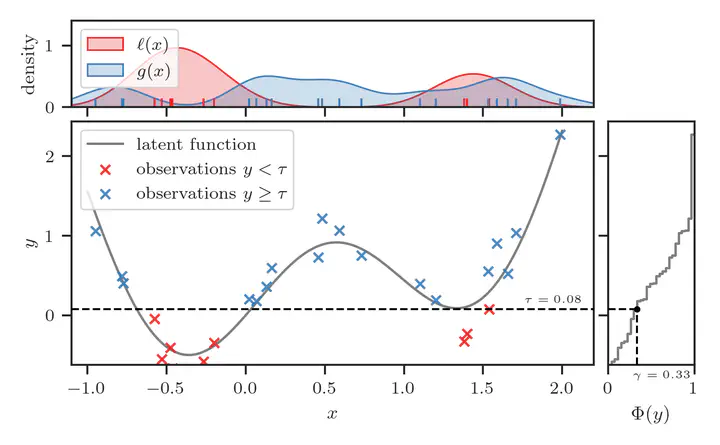BORE: Bayesian Optimization by Density-Ratio Estimation

Abstract
Bayesian optimization (BO) is among the most effective and widely-used blackbox optimization methods. BO proposes solutions according to an explore-exploit trade-off criterion encoded in an acquisition function, many of which are derived from the posterior predictive of a probabilistic surrogate model. Prevalent among these is the expected improvement (EI). Naturally, the need to ensure analytical tractability in the model poses limitations that can ultimately hinder the efficiency and applicability of BO. In this paper, we cast the computation of EI as a binary classification problem, building on the well-known link between class probability estimation (CPE) and density-ratio estimation (DRE), and the lesser-known link between density-ratios and EI. By circumventing the tractability constraints imposed on the model, this reformulation provides several natural advantages, not least in scalability, increased flexibility, and greater representational capacity.
Bayesian Optimization (BO) by Density-Ratio Estimation (DRE), or BORE, is a simple, yet effective framework for the optimization of blackbox functions. BORE is built upon the correspondence between expected improvement (EI)—arguably the predominant acquisition functions used in BO—and the density-ratio between two unknown distributions.
One of the far-reaching consequences of this correspondence is that we can reduce the computation of EI to a probabilistic classification problem—a problem we are well-equipped to tackle, as evidenced by the broad range of streamlined, easy-to-use and, perhaps most importantly, battle-tested tools and frameworks available at our disposal for applying a variety of approaches. Notable among these are Keras / TensorFlow and PyTorch Lightning / PyTorch for Deep Learning, XGBoost for Gradient Tree Boosting, not to mention scikit-learn for just about everything else. The BORE framework lets us take direct advantage of these tools.
Code Example
We provide an simple example with Keras to give you a taste of how BORE can
be implemented using a feed-forward neural network (NN) classifier.
A useful class that the bore package provides is MaximizableSequential,
a subclass of Sequential from
Keras that inherits all of its existing functionalities, and provides just
one additional method.
We can build and compile a feed-forward NN classifier as usual:
from bore.models import MaximizableSequential
from tensorflow.keras.layers import Dense
# build model
classifier = MaximizableSequential()
classifier.add(Dense(16, activation="relu"))
classifier.add(Dense(16, activation="relu"))
classifier.add(Dense(1, activation="sigmoid"))
# compile model
classifier.compile(optimizer="adam", loss="binary_crossentropy")
See First contact with Keras from the Keras documentation if this seems unfamiliar to you.
The additional method provided is argmax, which returns the maximizer of
the network, i.e. the input
x_argmax = classifier.argmax(bounds=bounds, method="L-BFGS-B", num_start_points=3)
Since the network is differentiable end-to-end wrt to input
Using this classifier, the BO loop in BORE looks as follows:
import numpy as np
features = []
targets = []
# initialize design
features.extend(features_initial_design)
targets.extend(targets_initial_design)
for i in range(num_iterations):
# construct classification problem
X = np.vstack(features)
y = np.hstack(targets)
tau = np.quantile(y, q=0.25)
z = np.less(y, tau)
# update classifier
classifier.fit(X, z, epochs=200, batch_size=64)
# suggest new candidate
x_next = classifier.argmax(bounds=bounds, method="L-BFGS-B", num_start_points=3)
# evaluate blackbox
y_next = blackbox.evaluate(x_next)
# update dataset
features.append(x_next)
targets.append(y_next)
Let’s break this down a bit:
At the start of the loop, we construct the classification problem—by labeling instances
q=0.25quantile of all target values as positive, and the rest as negative.Next, we train the classifier to discriminate between these instances. This classifier should converge towards
Once the classifier is a decent approximation to
How is it justifiable to use this in lieu of EI, or some other acquisition function we’re used to? And what is so special about
Well, as it turns out,
The remainder of the loop should now be self-explanatory. Namely, we
evaluate the blackbox function at the suggested point, and
update the dataset.
Step-by-step Illustration
Here is a step-by-step animation of six iterations of this loop in action, using the Forrester synthetic function as an example. The noise-free function is shown as the solid gray curve in the main pane. This procedure is warm-started with four random initial designs.
The right pane shows the empirical CDF (ECDF) of the observed
The instances below this horizontal line are assigned binary label
Finally, the maximizer of the classifier is represented by the vertical solid green line. This is the location at which the BO procedure suggests be evaluated next.

We see that the procedure converges toward to global minimum of the blackbox function after half a dozen iterations.
To understand how and why this works in more detail, please read our paper! If you only have 15 minutes to spare, please watch the video recording of our talk!